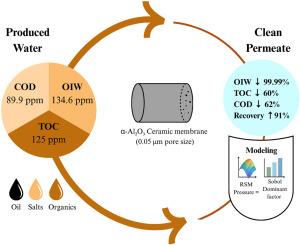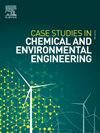Purification of oil produced water using ceramic membrane: an experimental and response surface model analysis
Q1 Environmental Science
Case Studies in Chemical and Environmental Engineering
Pub Date : 2025-09-27
DOI:10.1016/j.cscee.2025.101288
引用次数: 0
Abstract
The treatment of produced water remains a pressing challenge in the oil and gas sector, given its complex mixture of dispersed oil, dissolved organics, salts, and suspended solids. In this study, we examined the performance of a ceramic α-Al2O3 membrane (50 nm pore size) under cross-flow operation for real produced water, across a practical range of pressures (1.3–7 bar) and temperatures (25–45 °C). Unlike many previous investigations that relied on synthetic emulsions or limited operating windows, this work uniquely combines real-field oily water testing with response surface modeling (RSM) and Sobol sensitivity analysis to disentangle the relative roles of pressure and temperature.
The membrane achieved oil-in-water (OIW) rejection between 78 % and 99.99 %, reducing concentrations to as low as 0.15 ppm. Turbidity rejection consistently exceeded 96 %, while TOC and COD reductions ranged from 30 to 60 % and 0.36–62 %, respectively. Permeate flux reached up to 150 L m−2 h−1, with apparent permeability values between 150 and 210 L m−2 h−1·bar−1, and recovery peaked at 91 %. Sensitivity analysis identified pressure as the dominant operating parameter, whereas temperature introduced competing effects of viscosity reduction and fouling enhancement.
These results provide evidence that ceramic membranes can offer reliable separation performance for untreated produced water, while the integration of RSM and Sobol analysis delivers a novel quantitative framework for optimizing operating conditions. The study highlights both the opportunities and trade-offs of deploying ceramic membranes at scale, offering insights directly relevant to regulatory compliance and water reuse strategies in oilfield applications.

陶瓷膜净化采出水的实验及响应面模型分析
由于采出水是分散的油、溶解的有机物、盐和悬浮固体的复杂混合物,因此采出水的处理仍然是油气行业面临的一个紧迫挑战。在这项研究中,我们测试了陶瓷α-Al2O3膜(孔径为50 nm)在实际生产水中的横流操作下,在实际压力(1.3-7 bar)和温度(25-45°C)范围内的性能。与以往依赖于合成乳液或有限操作窗口的许多研究不同,这项工作独特地将现场油水测试与响应面建模(RSM)和Sobol灵敏度分析相结合,以解开压力和温度的相对作用。该膜对水包油(OIW)的截留率在78% ~ 99.99%之间,可将OIW浓度降低至0.15 ppm。浊度去除率一直超过96%,而TOC和COD的减少幅度分别为30%至60%和0.36 - 62%。渗透率最高可达150 L m−2 h−1,表观渗透率在150 ~ 210 L m−2 h−1·bar−1之间,采收率达到91%。敏感性分析表明压力是主要的操作参数,而温度则引入了粘度降低和结垢增强的竞争效应。这些结果证明,陶瓷膜可以为未经处理的产出水提供可靠的分离性能,而RSM和Sobol分析的集成为优化操作条件提供了新的定量框架。该研究强调了大规模部署陶瓷膜的机遇和权衡,为油田应用中的法规遵从性和水再利用策略提供了直接相关的见解。
本文章由计算机程序翻译,如有差异,请以英文原文为准。
求助全文
约1分钟内获得全文
求助全文
来源期刊

Case Studies in Chemical and Environmental Engineering
Engineering-Engineering (miscellaneous)
CiteScore
9.20
自引率
0.00%
发文量
103
审稿时长
40 days
 求助内容:
求助内容: 应助结果提醒方式:
应助结果提醒方式:


